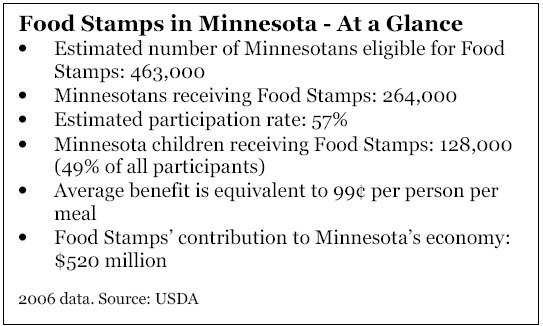Food Stamps Provide Critical Support to Minnesota’s Families
Food Stamps are the nation’s most successful anti-hunger initiative and prevent costly health problems associated with hunger and malnutrition. Today almost one in five American children live in families that use Food Stamps to afford an adequate diet.[1] Malnutrition can be especially damaging to the mental and physical development of young children, which in turn harms their ability to succeed in school and later in life.[2]

Food Stamps are the nation’s most successful anti-hunger initiative. One in 20 Minnesotans is helped by Food Stamps, and of the total amount of Food Stamps spent in Minnesota, 77 percent are used by families with children. Most of the remainder are used by elderly people or people with disabilities. The typical Minnesota family with children using Food Stamps has an annual income (not including Food Stamps) at just 41 percent of the federal poverty line, or $6,809 for a family of three.
In recent years, the rising cost of necessities like utilities, housing and health care, combined with stagnant wages and a weak economy, have increased the need for Food Stamps. From 2000 to 2006, the number of Minnesotans using Food Stamps grew by 35 percent. Now more than ever, Food Stamps are an important support for Minnesota families.[3]
House Farm Bill Prevents Further Erosion in Purchasing Power of Food Stamps
On July 27, the U.S. House of Representatives passed a Farm Bill (H.R. 2419) that included a $3.4 billion increase in funding for Food Stamps, strengthening the country’s commitment to fighting malnutrition and hunger.[4] The increase is funded in part by closing an unintended tax loophole that allows U.S. subsidiaries of foreign companies to pay lower taxes.
The House Farm Bill would help reverse the decade-long erosion in the purchasing power of Food Stamps. In Minnesota, 80 percent of households using Food Stamps see their purchasing power diminish every year. The result is $24 a month less in groceries in 2008 for a typical working family of three, compared to what they could purchase if the value of Food Stamps had not been frozen in 1996.
The average amount of Food Stamps in Minnesota — the equivalent of 99 cents per person per meal – is already too low for families to afford healthier foods like fresh fruits and vegetables. The House Farm Bill would make up some of the lost value and prevent further erosion of the purchasing power of Food Stamps. For 186,000 Minnesotans, the change will amount to an additional $5 million in Food Stamps in FY 2008 — or an additional $5 a month in Food Stamps for a typical family.
The House Farm Bill makes other positive changes to Food Stamps, including:
- The minimum amount of Food Stamps a person can receive will increase from $10 a month to $16 a month, and begin to be adjusted for inflation. This provision primarily affects seniors and people with disabilities. This provision would bring an additional $2.2 million in Food Stamps to Minnesota in Fiscal Year 2008. This change is long overdue, as the minimum amount has not been adjusted for inflation in thirty years.
- Food Stamps’ reach will be modestly extended by raising the limits on the amount of assets that people can have and still be eligible for help. The current Food Stamp asset limits are $2,000 for most households and $3,000 for households that include seniors or people with disabilities. These limits will now be adjusted for inflation. The House bill would not count tax-preferred retirement savings accounts and education accounts when determining a household’s assets. In addition, for families with children, the full cost of child care will be subtracted from the family’s income when calculating a family’s Food Stamp amount, resulting in a higher value of Food Stamps. Currently the amount of child care costs that can be deducted is capped. These last two proposals were also included in the President’s budget.
- The Farm Bill makes permanent a current policy that ensures that families of military personnel don’t see a cut in their Food Stamps when their family members are deployed to combat zones. Special combat pay will not be counted as income when determining a family’s Food Stamps.
- Food Stamps would be renamed the Secure Nutrition Access Program (SNAP), reflecting the fact that Food Stamps are now provided electronically through debit-like cards.
Next Steps
The portion of the Farm Bill that funds nutrition programs — technically termed the “Nutrition Title” — is just one component of a large piece of legislation that sets national agriculture policy for the next five years. The President has already threatened to veto the Farm Bill, citing concerns with its approach to commodity reform and the revenue generated from the change in tax law.
The U.S. Senate is expected to take up its version of the Farm Bill when Congress returns from its summer recess in September. House and Senate members will then work to resolve the differences between the two bills in conference committee, in the hopes of sending a bill to the President by the end of September. The Minnesota Budget Project continues to call upon policymakers to take a strong stand in support of Food Stamps as part of a renewed commitment to eliminate hunger and malnutrition in our communities.
[1] Except where otherwise noted, information in this section comes from the U.S. Department of Agriculture, Food and Nutrition Service.
[2] Children’s Sentinel Nutrition Assessment Program, Food Stamps as Medicine: A New Perspective on Children’s Health.
[3] See also Minnesota Budget Project, Fighting Hunger in Minnesota: The Critical Role of Food Stamps.
[4] Information in this section comes from the Center on Budget and Policy Priorities, 2007 Farm Bill: Description of the House Agriculture Committee Nutrition Provisions.